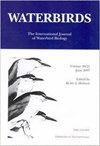Comparing In-Person Versus Camera Monitoring of Shorebird Reproductive Success
IF 0.6
4区 生物学
Q3 ORNITHOLOGY
引用次数: 1
Abstract
Abstract. Shorebird reproductive success monitoring often relies on surveys of nest and brood survival. However, conclusions may be inaccurate due to the challenges of gathering and interpreting evidence of nest and brood fate. We tested the efficacy of in-person versus camera-based monitoring to quantify productivity and evaluate threats to reproductive success of American Oystercatchers (Haematopus palliatus) and Piping Plovers (Charadrius melodus) at Metompkin Island, Virginia. We deployed 73 cameras using three set-ups: at nests, at brood sites, and along a transect. The same areas were also surveyed in-person approximately once per week. Camera monitoring confirmed nest fate where in-person monitors could not determine fate from field evidence and provided insight to the effectiveness of mammalian predator removal. However, cameras failed to capture causes of mortality for mobile chicks and did not consistently document chicks where in-person monitoring confirmed successful broods. Cameras produced large quantities of data requiring 63.5–315 hours to review, depending on camera set-up. We found cameras were useful for validating conclusions from in-person monitoring, highlighting threats that surveys missed, and characterizing the predator community. Managers should consider the tradeoff between potential benefits and required effort of camera monitoring when deciding which method would be effective for meeting management goals.比较现场与摄像机监测的滨鸟繁殖成功
摘要对滨鸟繁殖成功与否的监测通常依赖于对巢和雏鸟存活率的调查。然而,由于收集和解释巢穴和后代命运证据的挑战,结论可能不准确。我们测试了面对面监测与基于摄像机的监测的有效性,以量化生产力并评估弗吉尼亚州Metompkin岛美国捕牡蛎者(Haematopus palliatus)和管鸻(Charadrius melodus)繁殖成功的威胁。我们用三种方式部署了73台摄像机:在鸟巢,在产卵地点,沿着一个样带。同样的地区也进行了大约每周一次的面对面调查。摄像机监测确认了鸟巢的命运,而现场监测无法从现场证据确定鸟巢的命运,并为清除哺乳动物捕食者的有效性提供了见解。然而,摄像机未能捕捉到流动雏鸡死亡的原因,也没有始终如一地记录亲自监测确认成功孵出雏鸡的雏鸡。摄像机产生的大量数据需要63.5-315小时的审查时间,具体取决于摄像机的设置。我们发现,摄像机在验证现场监测得出的结论、突出调查遗漏的威胁以及描绘捕食者群体特征方面很有用。当决定哪种方法能够有效地满足管理目标时,管理人员应该考虑潜在利益和摄像机监控所需努力之间的权衡。
本文章由计算机程序翻译,如有差异,请以英文原文为准。
求助全文
约1分钟内获得全文
求助全文
来源期刊

Waterbirds
生物-鸟类学
CiteScore
1.30
自引率
0.00%
发文量
0
审稿时长
6-12 weeks
期刊介绍:
Waterbirds is an international scientific journal of the Waterbird Society. The journal is published four times a year (March, June, September and December) and specializes in the biology, abundance, ecology, management and conservation of all waterbird species living in marine, estuarine and freshwater habitats. Waterbirds welcomes submission of scientific articles and notes containing the results of original studies worldwide, unsolicited critical commentary and reviews of appropriate topics.
 求助内容:
求助内容: 应助结果提醒方式:
应助结果提醒方式:


